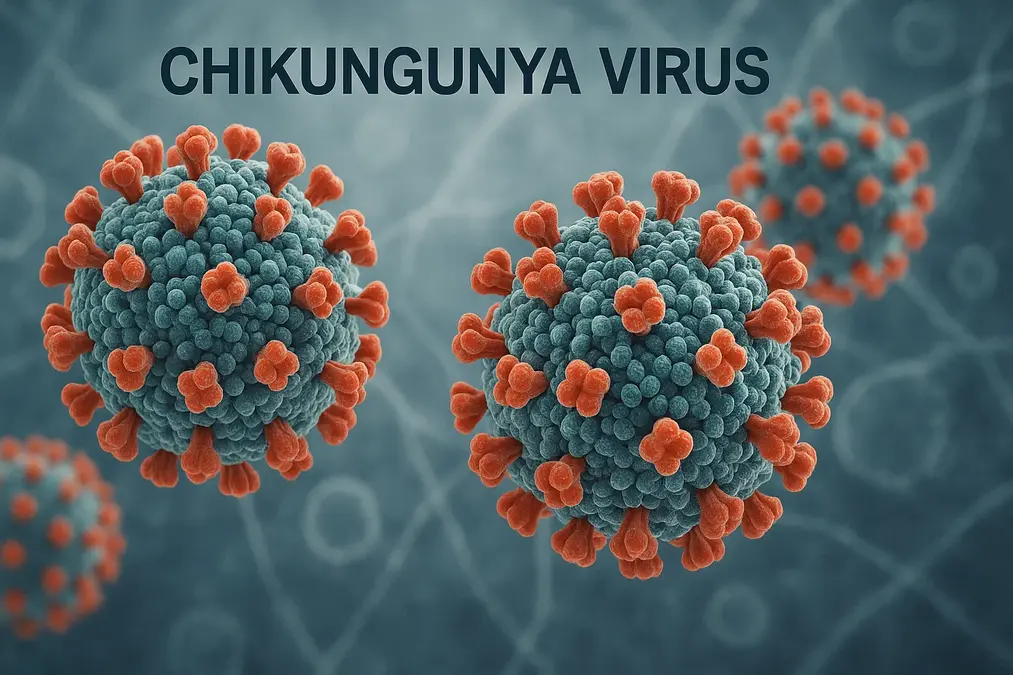🦟 Chikungunya virus is once again making headlines as the World Health Organization (WHO) has issued an urgent warning about its potential to become a major global epidemic. The agency is picking up early warning signs eerily similar to those observed before a massive outbreak two decades ago.
"Chikungunya virus is not widely known, but it has been detected in 119 countries, putting 5.6 billion people at risk," said Diana Rojas Alvarez of WHO.
🦠 What is Chikungunya Virus?
Chikungunya is a disease transmitted primarily by mosquitoes. The infectious disease is characterized by sudden fever, severe pain in the joints, muscle pains, rash, and fatigue. Notably, some patients can go on to develop certain debilitating chronic arthritis that can last months.
The disease is confused most often with dengue fever and infection with the Zika virus. The diagnosis is complicated by the similarities in clinical symptoms. Some aspects help differentiate these diseases. Unlike dengue, chikungunya is rarely fatal, however, the rate of infection is significant and can have serious effects upon the population.
📈 WHO Raises Alarm: Is This Another Global Epidemic?
WHO experts warned that the Chikungunya virus transmission pattern is already similar to that of the epidemic of 2004–2005, which originated from islands in the Indian Ocean and spread worldwide, infecting almost 500,000 people.
Since early 2025 there have been significant outbreaks in Reunion, Mayotte and Mauritius. Alarmingly, it is estimated that almost one-third of the population of Reunion is infected. The virus has now also spread to the Madagascar, Somalia, Kenya and South Asia- a sign of increased risk.
💡 Also Read: Global Heatwave 2025: Impact on Health and Disease Spread
🦟 2. Outbreaks in Reunion, Mayotte, and Mauritius
- “Since early 2025, major outbreaks have erupted… including La Réunion, Mayotte, and Mauritius, where one-third of La Réunion’s population is estimated to have been infected,” WHO stated
- The European Centre for Disease Prevention and Control (ECDC) reported over 51,000 chikungunya cases in Réunion and 560 cases in Mayotte by early June 2025
- A WHO Disease Outbreak News bulletin noted 47,500 confirmed cases and 12 deaths in Réunion as of May 4, 2025

🌐 3. Spread to Madagascar, Somalia, Kenya, and South Asia
- Kenya, Madagascar, Mauritius, Mayotte, Réunion, Somalia, and Sri Lanka have all seen confirmed outbreaks per the CDC and WHO travel health alerts
- Reuters also mentions the virus’s spread into Madagascar, Somalia, Kenya, and Southeast Asia (including India)
✅Chikungunya Virus 2025 Outbreak Table
| Region | Status (2025) | Details |
|---|---|---|
| Indian Ocean Islands | Pattern Match | Similar to 2004–2005 outbreak (~500,000 infected) |
| Réunion | Severe Outbreak | One-third of population infected (~47k–51k cases) |
| Mayotte & Mauritius | Major Outbreaks | Thousands infected; rapid transmission confirmed |
| Madagascar, Somalia, Kenya | Active Spread | WHO confirms ongoing transmission |
| South Asia | Early Cases Detected | Including India and Sri Lanka |
🦟 How Chikungunya Virus Spreads?
The Chikungunya virus is transmitted to humans through bites of infected female mosquitoes, mainly:
- 🦟 Aedes aegypti
- 🦟 Aedes albopictus (commonly known as the tiger mosquito)

These mosquitoes are active during the day, especially early mornings and late afternoons. The tiger mosquito, once restricted to tropical zones, is now moving into northern regions due to climate change.
🌍 Explore More: How Plastic Pollution Fuels Mosquito Breeding in Urban Areas
🛡️ WHO’s Safety Guidelines to Prevent Infection
The WHO emphasizes prevention as the first line of defense, especially in vulnerable countries:
✅ Use mosquito repellent
✅ Avoid stagnant water in containers
✅ Wear long-sleeved clothing
✅ Install window screens or use mosquito nets
✅ Keep water containers covered
⚠️ Why WHO Is Urging Global Preparedness Now?
While chikungunya Virus fatality rate is under 1%, large outbreaks mean thousands of lives could be lost, especially in low-resource regions.
“We are raising the alarm early so countries can prepare early, detect and strengthen all the capacities to avoid going through very large outbreaks,” said Rojas Alvarez.
Regions with no prior immunity may see epidemics affecting up to 75% of the population.
🦠 Conclusion: A Global Health Crisis We Can’t Ignore
The Chikungunya Virus Outbreak of 2025 evolved into more than a regional epidemic. It’s now moving as a full-blown global epidemic. With more than a third of the populations in islands like Réunion already infected, and in Africa and Asia, the WHO’s response with a red alert outlines the stark projection.
There is no vaccination as of Chikungunya Virus yet, however prevention is our most vigilant defense. Governments, health agencies public and private, and individuals must act now; using vector control, awareness campaigns nationally, and international collaboration to mitigate a global catastrophe.
If we dismiss the patterns of past epidemics, we do so at our own peril. There may still be a chance to eliminate Chikungunya Virus, but only with a swift response we can prevent any further escalation of the virus infectious public health infrastructure until we fully understand it.
🔍 Frequently Asked Questions
What is the Chikungunya virus?
Chikungunya virus is a mosquito-borne virus that causes fever, severe joint pain, muscle aches, headache, fatigue, and rash. It spreads mainly through Aedes aegypti and Aedes albopictus mosquitoes.
How did the 2025 Chikungunya outbreak start?
The 2025 outbreak began in islands like Réunion, Mayotte, and Mauritius, following patterns similar to the 2004–2005 epidemic. It has since spread to parts of Africa and South Asia, prompting a WHO red alert.
What are the symptoms of Chikungunya?
Common symptoms include sudden high fever, joint swelling, rash, muscle pain, and fatigue. These symptoms typically appear 4–8 days after a mosquito bite and may last weeks or even months.
Is there a cure or vaccine for Chikungunya in 2025?
Currently, there is no approved vaccine or antiviral treatment for Chikungunya. Supportive care like hydration, pain relief, and rest is the primary management approach. Research is ongoing to develop a vaccine.
How can I protect myself from the Chikungunya virus?
Use insect repellents, wear long sleeves and pants, use mosquito nets, and eliminate standing water around your home. Stay informed via health authorities and consider traveling cautiously to outbreak zones.
Which regions are affected by the 2025 outbreak?
Major outbreaks have been reported in Réunion (over one-third population affected), Mayotte, Mauritius, Madagascar, Somalia, Kenya, and parts of South Asia.




